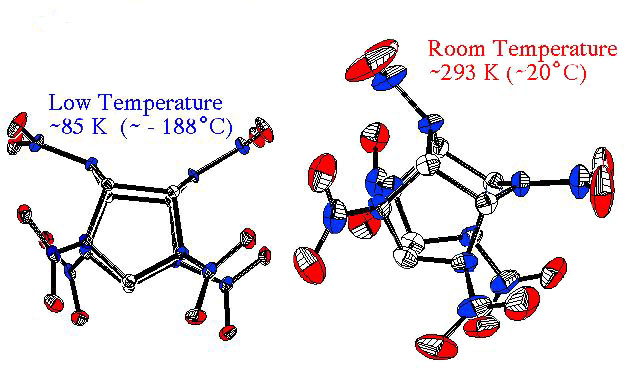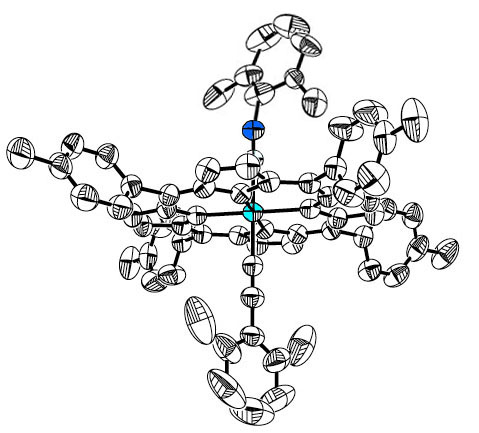(You may need to "zoom out" (hit both the ctrl and - keys simultaneously) 2-4 times to see this all on-screen at one time)
All atoms vibrate within the crystalline lattice.
The vibration increases with temperature.
This vibration is one factor (among others) that are together termed "thermal motion."
Thermal Ellipsoids
The Ugly (misassignment of atomic type)
Thermal Paramters
Anisotropic (Uij)
Thermal ellipsoid plots, such as those drawn using the program ORTEP (Oak Ridge Thermal Ellipsoid Plot) have become a familiar way to present crystallographic results.
The relative sizes, shapes and orientations of the ellipsoids in these plots convey information.
In a well-behaved structure, the ellipsoids will be of similar size, low anisotropy (nearly spherical), and of coherent orientation.
In a poorly behaved structure, the ellipsoids may be of significantly different sizes.
The ellipsoids may be very elongated or flattened, or have incoherent orientations.
A high degree of anisotropy may reflect conformational differences, disorder, or more serious problems.
Thermal Ellipsoids: The Good (or at least normal)
The thermal ellipsoids in this structure are typical for small molecule structures at about 20 degrees C.
Ideally, all thermal ellipsoids would be nearly spherical (isotropic).
This is frequently true for heavy atoms and the atoms bound directly to them.
However, atoms at the ends of long chains normally show greater anisotropy (are more "football" shaped).
Conformational differences also contribute to anisotropy.

Thermal Ellipsoids: The Better (low temperature)
As thermal motion is temperature dependent, bathing a crystal in a stream of cold gas will lower the amplitude of the atomic vibrations.
Thermal Ellipsoids: The Bad (disorder)
There is obviously a serious problem with this structure.
Two of these organic isonitriles are axial ligands on a ruthenium porphyrin complex.

This molecule had D2h point group symmetry.
The principal C2 axis coincides with the two-fold axis of the C2/c space group.
However one of the ligands is off axis.
This ligand is disordered about the crystallographic two-fold axis.
In one half of the unit cells it is in one orientation, and it is in the alternate orientation in the remaining unit cells.
The summation of the two orientations results in poor atomic positions.
Much of this positional error is reflected in the thermal parameters when the structure has not been modelled correctly.
Thermal Ellipsoids: The Ugly (misassignment of atomic type)
The relatively large size of atoms assigned as oxygens, relative to those assigned as carbons, suggests a major blunder!
Here the oxygens are misassigned as carbons and the carbons as oxygens. Note the irregular sizes of the thermal ellipsoids.
Here all atomic types are correctly assigned.
The thermal ellipsoids are all normal in size and shape.
Thermal motion diminishes the scattering power of the atoms.
B represents the thermal parameter.
u represents the amplitude of atomic vibration.
An exercise called "ScatFac" is available for Windows that allows you to investigate scattering factors.
Thermal Parameters: Isotropic (U or B)
Typical values are
or
The average vibrational amplitude, the square root of U, is multiplied by a constant, C, derived from probability theory, to determine the radius of the sphere plotted for an isotropic atom.

Thermal Parameters: Anisotropic (Uij)
Six parameters are used to describe anisotropic thermal motion. They are diagonal and off diagonal terms of a three-by-three matrix.
An isotropic ellipsoid would have all off-diagonal terms equal to zero,
and all diagonal terms are the same.

However, if
the third diagonal term differs, the ellipsoid elongates along a cell edge.




Whereas if
the third off-diagonal term differs, the ellipsoid elongates at an angle to the cell edges.


Thermal Parameters: Anisotropic Scattering
To correct the scattering factor for anisotropic thermal motion ...
Thermal Parameters: From Numbers to Pictures
How do the numbers relate to the picture?
In three dimensions the calculations to translate the thermal parameters into the thermal ellipsoids are rather complicated, particularly for non-orthogonal cells. Following are examples in two dimensions.
In two dimensions a simple ellipse is defined by the equation below.
Thermal Parameters: Compare Quantitative with Qualitative
The following example compares the quantitative and qualitative aspects of thermal motion.
Recall that thermal motion tends to increase for the atoms at the ends of long chains.
A plot of the isotropic equivalent for the average amplitude of displacement quantififes this increasing anisotropy.
The anisotropic terms show greater vibrations perpendicular to the axis of the chain than along the chain axis.
Vibration perpendicular to the chain, and ~parallel to the cell edge "c."
Note: the difference in the magnitude of vibration along the chain is less than that perpendicular to the chain.